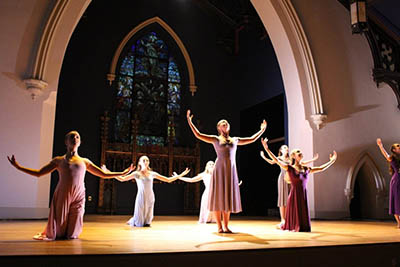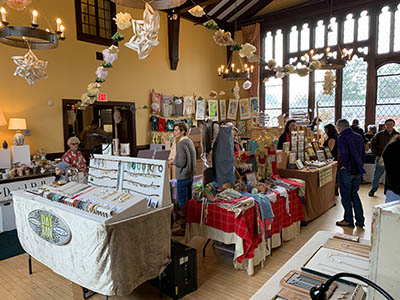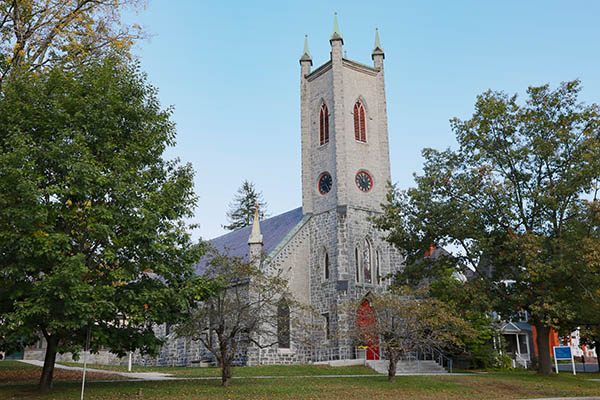Once the westernmost outpost of the Episcopal Church in America, and not long ago very close to demolition, the former St. James Episcopal Church in downtown Great Barrington, Massachusetts, has now found a new life as Saint James Place, a Cultural Center and Home for the Arts. The 1857-vintage building offers 17,000 square feet of renovated space that breathes with artists, their audiences, and the larger Berkshires community.
Great Barrington has seen its fair share of hardship as industry jobs left, compounded by the major recession a decade ago, but its rebirth as a culture-rich town has created an opening for a new center for the arts. Nestled on a prominent corner of Main Street, “the gateway to Great Barrington,” Saint James Place (SJP) has become a landmark of the Western Massachusetts cultural community.
St. James Parish was established in 1762 and the current building was its third home. The building is faced with locally quarried dolomite limestone and its pointed arches are filled with beautifully crafted stained glass. In 1911, a parish house was added, complementing the original building with half timbered walls, dormers, and late Gothic windows. The building’s history continues to resonate today. For example, its parishioners supported Union soldiers with Bibles and banners as they departed to fight in the Civil War. During the 1918 influenza epidemic it became a hospital. This fall, 2019 Saint James Place partnered with the Great Barrington Historical Society to create a lecture series highlighting local history including Shays Rebellion and Elizabeth Freeman, a freed slave whose court case in Massachusetts was the catalyst for the abolition of slavery statewide.

Performance by the Olga Dunn Dance Company Photo: Olga Dunn Dance Company
In 1920 the organ was moved to another location in the building, prompting the addition of steel beams to reinforce the structural system in the sanctuary. However, ongoing structural problems resulted in the partial collapse of the rear chancel wall in 2008, compelling the congregation to worship elsewhere and consider demolition of the building. Sally Harris, a long-time seasonal resident and now a permanent resident of Great Barrington, who was also a member of the parish, envisioned a new life for the church. Sally and her husband Fred, driven by their love of the building and personal history with the space, embarked on a research project to find grant opportunities to support a new course for the church building. Through that research, they found Partners for Sacred Places and reached out to its president, Bob Jaeger.
Jaeger conferred with the Harrises, encouraging their work to bring new life to the church, and was invited to speak to the Great Barrington community about how old sacred places can be repurposed for the city and region. Sally and Fred Harris saw that they “were not alone” in their efforts, and toured other examples of reused churches for inspiration and information. They founded SJP in 2010, began to gather a board of directors, and brought Partners back to study the needs and wants of the Berkshires cultural community. Partners led an Arts Market Study and helped generate interest in SJP, which in turn led the way to $500,000 in funding from the Massachusetts Cultural Council.
To maximize support from the state, SJP connected with State Representative William “Smitty” Pignatelli, who recalls that “[Sally and Fred] got me there early in the process and convinced me that this could be a game changer in the future.” Pignatelli’s district is the largest in the state, and one of the most rural, and thus he was eager to invest in SJP’s future as a cultural economic engine of the Berkshires. “This church right on Main Street had fallen into disrepair. They have helped not just the corner but the entire region because of the location.” He adds that SJP “is the economic hub of the South Berkshires,” expanding the traditional tourist season beyond the summer and shoulder months.

The Great Barrington Arts Market Holiday Sale
Photo: The Great Barrington Arts Market Holiday Sale
“Saint James Place” says Chris Rembold, City Planner at the time of renovations, “…creates a great synergy with the Town Hall next door and the Mahaiwe Arts Center. It is a center of cultural and civic happening.” Local taxpayers agreed, voting to allocate 2019$150,000 towards the preservation of the former church, under the provisions of the city’s Community Preservation Act which permits a local property tax surcharge to support historic preservation. Although the Berkshires have seen many congregations shrink and close, the region puts considerable energy into preservation. SJP is not alone but is, says Rembold, “the most prominent and best example for reuse.”
SJP raised additional funds from foundations and state programs, including Massachusetts’ historic tax credit program, permitting the building to be fully restored and renovated as a home to both arts and social service nonprofits. Its intimate performance spaces have encouraged artists to use them year-round, which in turn has encouraged performers and audiences to patronize local restaurants and businesses in winter as well as summer. As Jim Frangione, the Artistic Director of the Great Barrington Public Theater, puts it so succinctly, “Every artistic organization needs a home and SJP is a home for us. A lot of programming is happening in the spring and fall that never happened before and SJP is a big reason why.”
Although SJP has hosted the worship services of one or two congregations for a few hours each week, the tradition of housing programs that benefit people in need continues every day. SJP provides rent-free space for The People’s Pantry, a food pantry serving many across southern Berkshire County; the money that would have been spent on rent can go toward programming and food instead. The Pantry has its own private accessible entrance, allowing it to expand their hours of operation without hindering other programming in the building. Suzannah VanSchaick, Board Member and volunteer at The People’s Pantry, notes that the region’s new “economic success can leave those in need to fade into the background.” SJP provides an “affordable, accessible, and attractive location for The People’s Pantry, providing a much needed balance within our community.”
The fact that Saint James Place provides space and support for both the arts and for social services suggests that St. James Episcopal Church’s long commitment to community lives on in unexpected ways. And SJP’s transition from church to community hub can inspire and encourage other communities to do the same. As Sally Harris would say, “you are not alone.”

